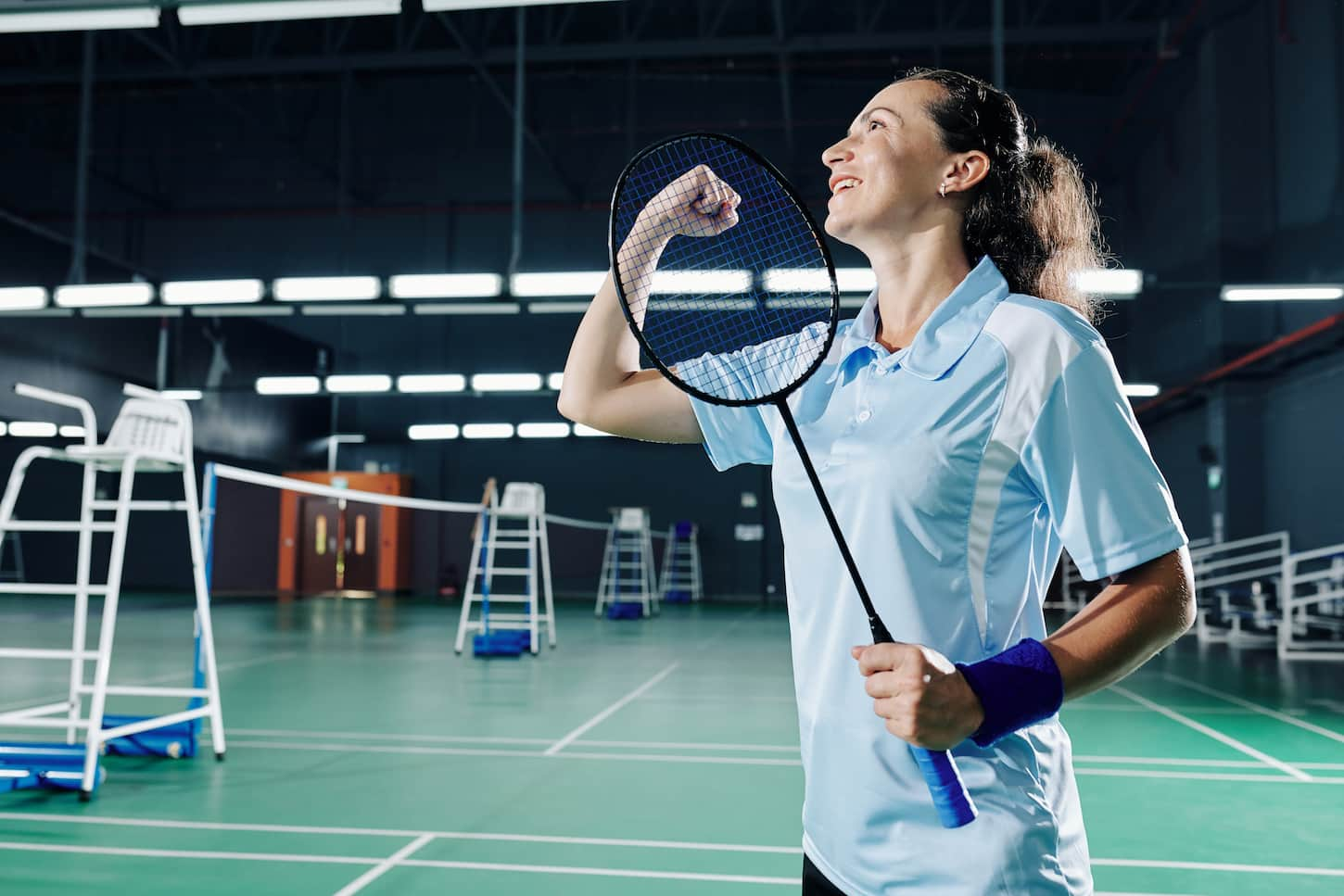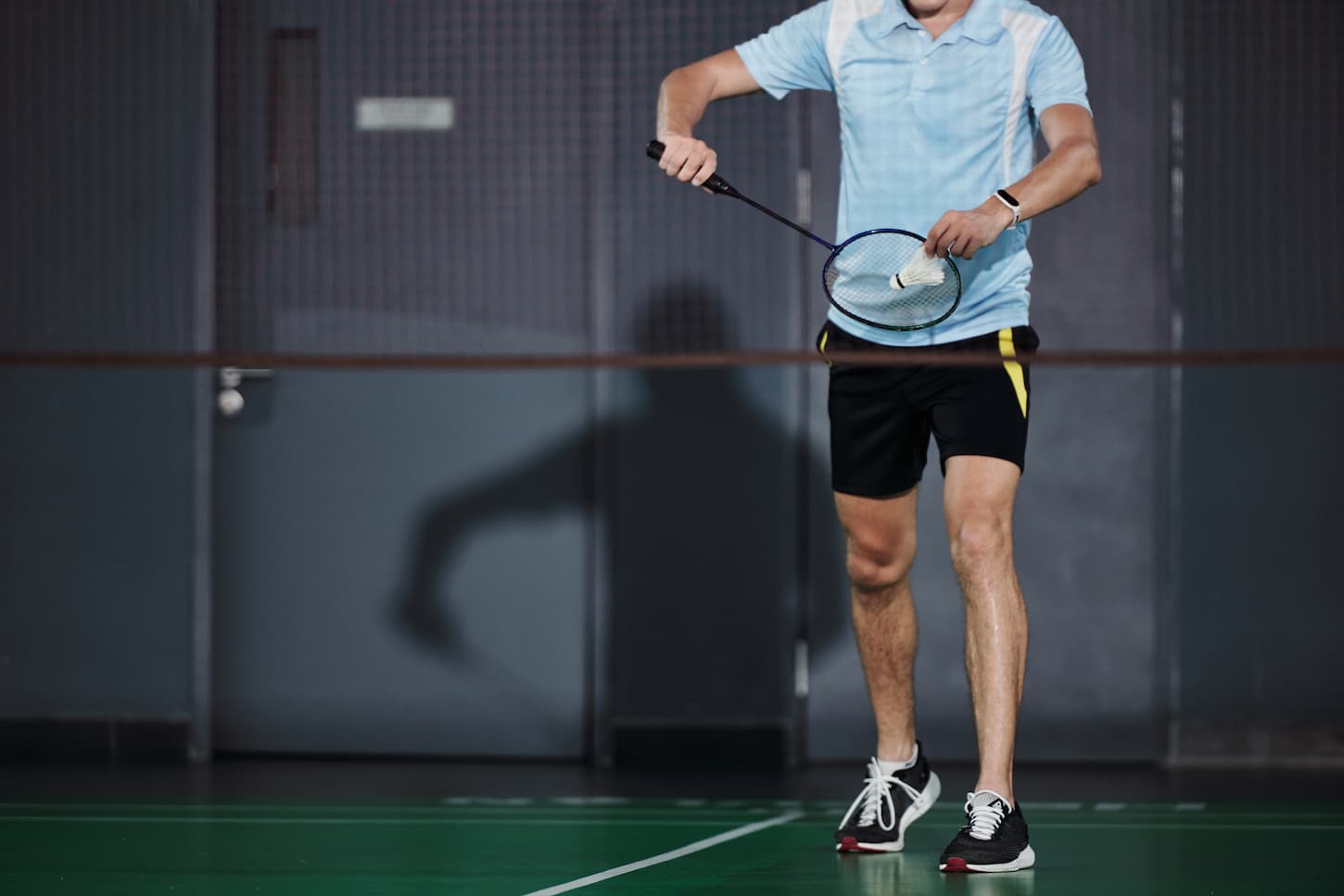Perfecting the serve in badminton will massively improve a game. There are plenty of ways to serve; depending on which one we choose, the shuttlecock will go to a different court area. Perfecting the serve requires plenty of practice and skill.
To perfect the serve in badminton, learn all the unique ways of serving. Progress through techniques one by one. Move on to the next technique after feeling comfortable with the previous one.
Playing singles or doubles will impact a player’s serve. It’s important to know multiple techniques for serving, as we cannot predict our opponent’s skill level. Perfecting different serves will not only keep opponents guessing but will allow us to change the game plan to challenge them best.

What Is the Perfect Serve in Badminton?
The perfect serve in badminton is one that is impossible for an opponent to return. It is about precision and speed. The closer to the net and the faster the serve, the more difficult it is for the opponent to return the shuttlecock. Entire games can be won with the right serve.
If we can add an element of unpredictability, this will also help to perfect the serve. If our opponent cannot read the serve we’re going to make; then they will struggle to react.
What Is the Easiest Serve in Badminton?
The easiest serve in badminton can be subjective to each player, but as a beginner, the backhand low serve is recommended to learn first. This serve is the easiest one to play consistently and effectively when practiced.
The serve that most players learn first is the low serve; this is a backhand serve. The second most common is a high serve; this is a forehand serve. It’s defined as backhand or forehand, depending on the grip used when executing the motion.
The low and high serves are considered the easiest as they can be quickly learned by beginners and are the basis for starting a game of badminton. With practice, both can be a great advantage to a player’s game, as a precise serve can be difficult for an opponent to return.
What Are the Two Types of Serves in Badminton?
There are two main types of serves in Badminton. These can be categorized by high or low. This relates to whether they land at the front (low serve) or back (high serve) of the court. In addition to this, we can use different movements to achieve low or high serves.
Badminton is played worldwide, so there is some variation in how many types of serves there are. We have outlined below two main serves that all beginners will learn regardless of where they are or who teaches them.

High serve
If a player wants to land a shuttle in the back end of the court, they need to use a high serve. The advantage of using a high serve is that an opponent won’t be able to smash the shuttlecock at us.
If we can force an opponent into using their backhand to return the shuttlecock, this will be a weaker return because most players’ backhand is weaker. High serves can also be referred to as long serves.
How to hit a high serve
How to hold the shuttlecock: Hold the shuttlecock at chest height and drop it into the path of the racquet. Focus on the timing, and don’t miss the shuttle; this will take practice.
When we “drop” the shuttlecock, this will be more of a light throw in front of our body. Aim for a short distance in front of the lead foot.
How to grip the racquet: Use a forehand grip when hitting a high serve. Grip the middle of the handle with the index finger a little loose to help control the racquet. Use the thumb and index finger to create a “V” shape on the handle to create a forehand grip.
How to position your body: Take a step back from the serving line to be closer to the playing position. Position the body to the side of the net and follow through with the racquet, twisting the body. Have your arms in a high neutral position
How to strike the shuttlecock: Move the racquet arm back and swing forward while rotating the body. Use it to create momentum when serving; rather than just the arm, use the back and legs to transfer weight and create a more powerful strike.
Where to strike the shuttlecock: Focus on the shuttlecock as it falls so your racquet will be on target to strike the shuttlecock. Strike the shuttlecock head with the center of your racquet to transfer the most energy.
The higher we hit the shot, the harder it is for an opponent to hit as the shuttle will fall at a steep angle, and it can be difficult to time a return shot. Players who did hit the shuttlecock will likely impact the feathers, which will take power out of their smash.
To avoid the shot landing out of bounds, aim for the ceiling rather than the back of the court. With practice, we will learn how much power is required to reach just inside the court lines.

Low serve
If we want to land the shuttlecock at the front of the court, we should use a low serve. The perfect low serve will fly very close to the net, almost grazing the top. If unreturned, it will land on the front service line.
This close-to-the-net serve limits the space and time available for the opponent to return a serve. Low serves can also be referred to as short serves.
How to hit a low serve
How to hold the shuttlecock: Hold the shuttlecock by the tip of the feathers and have the head of the shuttlecock facing downwards. As the head is the heaviest part of the shuttlecock, having it at the bottom will allow it to fall straight down.
Holding the shuttlecock by the feathers prevents our hand from getting in the way of the racquet.
How to grip the racquet: When gripping the racquet, move your grip up from the handle to hold the triangle at the top of the handle. Having the hand higher on the handle will give us more control of a racquet, allowing more precise movements.
We should have a standard backhand grip with our thumb against the back of the racquet.
How to position your body: Position the body as close to the serving line and mid-line as possible; the shuttlecock will have the shortest distance to travel over the net.
Reach out to the net with your arms, and lean into the front foot. Make sure the back foot is still touching the floor; otherwise, the service will be illegal.
How to strike the shuttlecock: To strike the shuttlecock, use a slight movement. Keep the shoulder and elbow locked, bring the racquet head back and push forward through the thumb, using the hand to create the movement.
Where to strike the shuttlecock: When striking the shuttlecock with a racquet, hit the shuttlecock with the strings towards the top of the racquet head. These strings have lower energy reducing the chance of the shuttlecock going off in a random direction.
Before bringing the racquet back, rest the shuttlecock on the racquet area you want to hit it with to ensure it is in line with the serve.
Mastering a low serve is essential to becoming a successful badminton player. The low serve is the most commonly used; it can be extremely difficult to return when executed correctly.
What Is Serve Skill in Badminton?
Serving is one of the most important skills in badminton. It is how all games start. We can start the game with an advantage if our serve is strong. The skills required for a good serve in badminton include timing, focus, aim, and power.
As with any sport, badminton requires lots of skills and the ability to use multiple skills simultaneously. We should learn the correct technique and practice to improve our serving skills.
Taking the time to do serving drills without an opponent is a great way to gain muscle memory for the ideal serving technique.
What Are the Hardest Serves in Badminton?
The hardest serves in badminton are the drive and flick serve. These are both backhanded serves. These are more advanced as they require skill and deception to be successful.
Perfecting these serves takes plenty of practice, but as they are more challenging to learn, it will put us ahead of our opponents if we can master them.
Drive (flat) serve
A drive serve is a new technique designed to catch an opponent off guard. This type of serve is fast, aiming to land between the middle and the back of the receiving area.
The drive serve is flat and tends to go toward an opponent’s head, making it difficult to return. Drive serves can also be referred to as flat serve.
A drive serve is performed in a similar way to the low serve, and it deceives opponents. The server will hit the shuttlecock with more power, driving it toward an opponent.
As this serve is unexpected, opponents often cannot react in time to return the serve. The key to a successful drive serve is deception; it’s important to hit the serve fast with a lot of power so the opponent doesn’t notice the change in technique from low to drive serve.

Flick serve
A flick serve is a backhand serve aiming to flick the shuttlecock toward the back of the receiving area. The set-up for this type of serve is the same as a low serve, so a player can deceive their opponent, making it difficult to return.
The goal of the flick serve is to quickly go over the receiver and land behind them, making it impossible to respond.
Flick serves tend to be used in double matches as the receiver will stand closer to the front service line giving plenty of room for the shuttlecock to land without being intercepted.
Key Takeaways and Next Steps
These tips and badminton playing styles are far beyond what you’ll usually find in a pickup game in the backyard with your family… unless you’re all really into badminton. If that’s the case, then it’s likely those pickup games are getting more competitive!
If that’s the case, then these tips will help you progress as a player. We must be humble when learning how to make the perfect badminton serve. Sometimes the simplest serve is the best to secure a win. Learning the basic serves inside and out is important before progressing to more technical ones.
Making the perfect serve is not just about the execution but a greater understanding of the game of badminton and our opponent’s strengths and weaknesses.
Practicing different serves and then being able to read the game and make modifications as we play will lead to us being able to make the perfect serve.
Do you love badminton? We have much more information about rules, equipment, and other FAQS. Check out these educational articles:
- Badminton Equipment: What You Need (and what you don’t)
- Badminton Costs: How Much It Costs to Get Started
- Can a Badminton Racket Cross the Net? (A Complete Guide)
- Playing Badminton: Rules, Instructions, and What’s In-Bounds
Resources
Learning from your own experiences is important, but learning from others is also smart. These are the sources used in this article and our research to be more informed as a family of sports nuts wannabes.
- Badminton Gripping Technique. (2016, September 5). Master Badminton. https://www.masterbadminton.com/badminton-gripping-technique.html
- Badminton Serve. (2016, September 5). Master Badminton. https://www.masterbadminton.com/badminton-serve.html
- Swift Badminton. (2018, August 10). Perfect Badminton Low Serve Every Time – BEST METHOD. YouTube. https://www.youtube.com/watch?v=O4X0LL7t2ys
- Tobias Wadenka. (2021, November 22). Badminton Forehand Serve Tutorial. YouTube. https://www.youtube.com/watch?v=AjsGVvK8vE4
